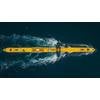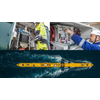Acoutic Pingers; Not Just for Airplane Black Boxes

Commercial diver with recovered ADCP & pinger, Inset - diver with PR-1 receiver (Courtesy JW Fishers)
The search for Malaysia Airlines Flight 370 has put a lot of undersea technology in the media spotlight. Equipment such as the Autonomous Underwater Vehicle (AUV) and Acoustic Pinger are now part of everyday conversations at workplaces and homes across the globe. Everyone now knows that pingers are underwater signaling devices, and a pinger receiver is used either by a diver or attached to an AUV to detect the sonar signal transmitted by the pinger. But putting an acoustic pinger on an airplane’s black box is only one of the many purposes for this device. Pingers have been around for a long time, and they are quietly being used by a diverse group of organizations and institutions.
The US Navy’s Underwater Construction Teams (UCT) routinely use acoustic pingers in their operations. Underwater Construction Teams were formed in 1974 when two detachments of Seabee divers were commissioned as UCT 1 and UCT 2. Their mission is to conduct underwater construction, repair, and demolitions. The teams employ pingers to mark the location of UXO (Unexploded Ordnance) for removal or disposal, and attach them to underwater sites divers need to relocate. The groups choose Fishers MFP-1 multifrequency pingers because each one can be set to transmit a different frequency. Having each pinger broadcasting a unique frequency means many can be deployed in the same general area and individual units can be quickly and easily relocated.
Researchers and scientists at many universities also rely on pingers. The Jackson School of Geosciences at the University of Texas in Austin has one of the most established and well regarded geoscience programs in the world. R. Wayne Wagner is a post doctoral fellow at the school’s Department of Geological Sciences, one of the country’s oldest geoscience departments. Dr. Wagner is trying to develop a better understanding of the affects of “land building” in coastal Louisiana. The term refers to coastal restoration and hurricane protection projects, which according to a recent study is the new “boom industry” for southeast Louisiana. An important piece of information for his research is knowing how water moves through coastal estuaries. To capture this data Dr. Wagner deploys a Nortek Aquadopp current profiler (ADCP) which is a device that measures speed and direction of water flow. The profiler must be retrieved to access the stored data. To ensure the profiler doesn’t get lost, Wagner’s team attaches one of Fishers SFP-1 single frequency pingers. This proved invaluable in a recent survey when the retrieval line on the ADCP was cut and a diver had to be deployed with the PR-1 pinger receiver to find it.
Another organization using pingers is the Khalid bin Sultan Living Oceans Foundation, a nonprofit environmental science and ocean research foundation established to help preserve, protect, and restore the world’s oceans and aquatic resources. Dedicated to ocean conservancy, the foundation was set up in 2000 by His Royal Highness Prince Khalid bin Sultan of Saudi Arabia who provided an extensive list of assets at its disposal including a research vessel and seaplane. The core staff is located in Washington, DC and works with research fellows and environmental groups from around the world including Science Without Borders. To gather the needed data on the health of the seas, foundation researchers use a variety of oceanographic instruments. Before deploying an instrument, the SFP-1 pinger is attached to to ensure its safe recovery. The group also employs Fishers TOV-1 towed video system allowing them to create a visual record of the marine ecosystem.
Fishers has recently added a new low frequency pinger to its extensive line of acoustic devices. The new model has a significantly longer transmission range (3-6 miles compared to 2,000-3,000 feet for a conventional pinger), a longer battery life, and a variety of other new features including delayed start which allows the pinger to lie dormant for up to a year before beginning to transmit.
jwfishers.com













 December 2025
December 2025



